The Ultimate Guide to Intent Data with Chris Rack
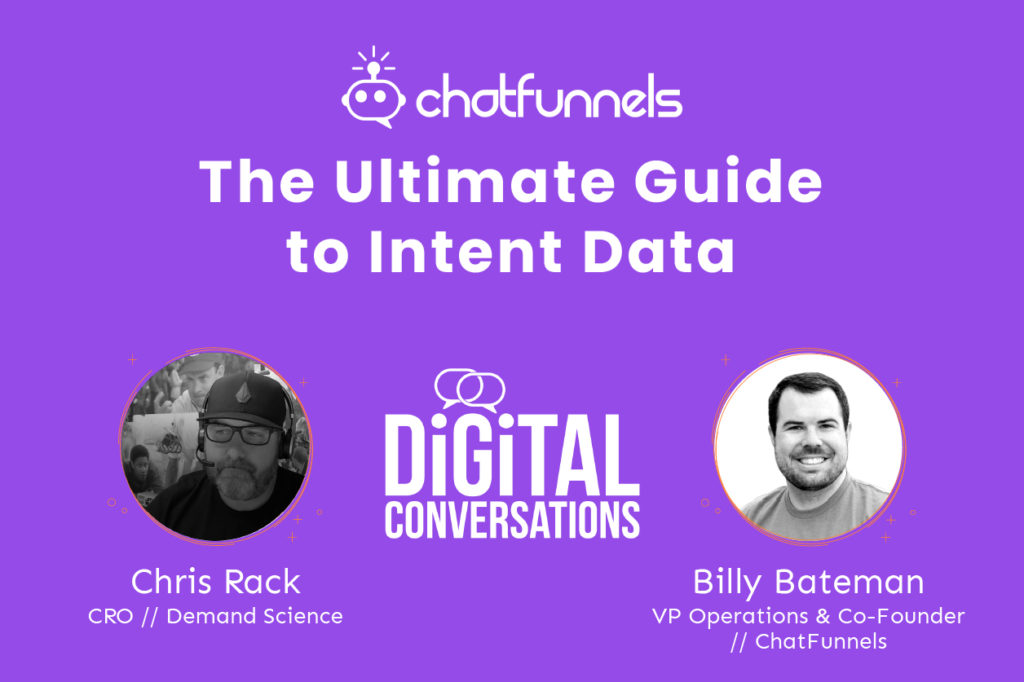
Overview
Chris Rack shares his experience and knowledge of how to source, interpret, and strategically make use of intent data.
Guest
Chris Rack is the CRO of Demand Science specializing in data and intelligence for the sales and marketing decision makers. He has successfully led four sales organizations that experienced 10x growth over a 2-to-3-year span as an individual contributor, middle manager, and executive leader. His leadership model is built on a strong foundation of process building, execution, and building winning cultures.
Reference
Intro
Billy Bateman 0:00
All right, everyone. Welcome to the podcast today. Today I’m joined by the one and only Chris Rack of Demand Science. How’re you doing? Chris?
Chris Rack 0:09
I’m good. How are you?
Billy Bateman 0:10
Doing good, doing good. I’m really excited about this. And it should be a fun conversation about how we use intent data for sales and as a sales team. But before we hop into that, man, you guys’ Demand Science, you’re doing some cool things. But tell us about Chris, what your journey has been to be the CRO, and then Demand Science for people who don’t know about you guys.
Chris Rack 0:35
Awesome. I appreciate it. So, I came to Demand Science in 2016. So, I’ve been here about five years. Demand science, we specialize in data and intelligence for the sales and marketing decision makers. So, you know, our product suite ranges from, you know, activation solutions, like syndication and ABM display to, you know, contact intelligence and intent intelligence through our platform solution. So, a pretty diverse portfolio across, you know, both the sales and marketing ecosystem.
Billy Bateman 1:09
Awesome, man. Awesome. And then, you know, what’s your, for people that are like, hey, how do I get to be the CRO? What’s, what’s been your journey to get there?
Chris Rack 1:18
Yeah, so in my journeys, it’s been fairly consistent. You know, I’ve always started out at every job before this one as an individual contributor. I’ve sold to the point where I moved myself into middle management, middle management, you know, then back to an individual contributor than middle management. I started in the demand generation, and, you know, marketing and sales solution space in 2006, with a company called eMedia.
And I’ve been through the journey with a company called Spiceworks, which was acquired by Ziff Davis, I was given the opportunity to kind of build the sales over here. Starting in 2016, when I joined, we were a team of three, making about 6 million bookings annually. And you know, by the end of this year, we will be a team of probably 133, doing just over 130 million.
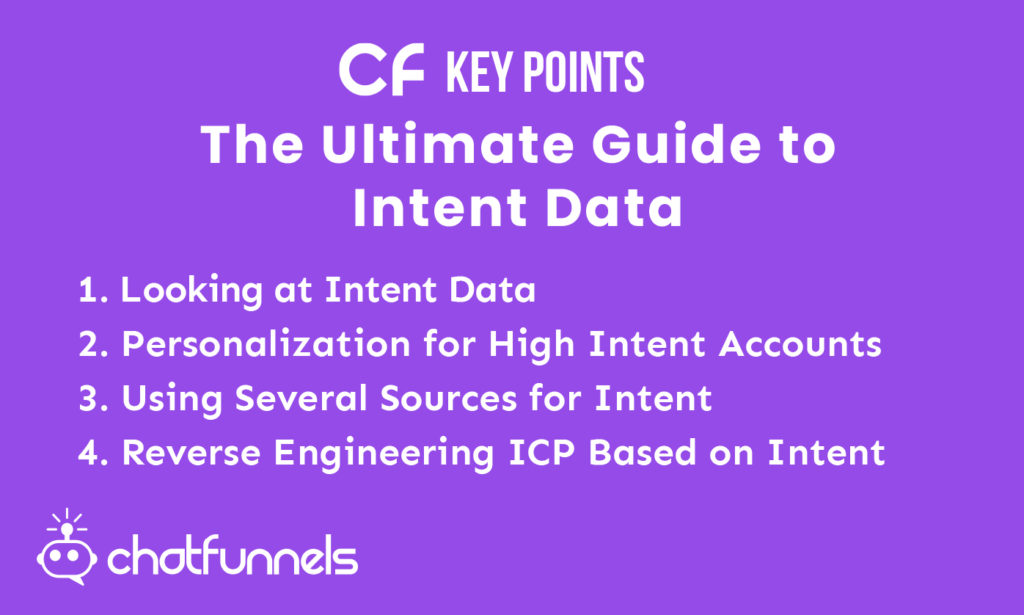
Billy Bateman 2:10
Wow, Impressive, impressive. So, I’m sure to get there. You know, it’s been five years since I quit the journey. But that’s so that’s a ton of growth. That’s awesome. So how do you guys like, let’s talk about this, I’m sure you guys use your own product as you’re selling. When you’re looking at intent data, like what do you see as actual intent data for sales? Like what metrics, what activities or are you looking at when you’re like, okay, I think this indicates some intent.
Looking at Intent Data
Chris Rack 2:42
Yeah. So, there’s a lot of different types of intent. Right? That’s the first the first thing to look as well, this started out many years ago, when we realized that and obviously, we’re a bootstrap company. So, we’ve never taken funding, or we’ve never taken, you know, so everything we’ve always done has been how could we do this most effectively? And obviously, effectiveness usually means a headcount. I didn’t have the budget early on, to go out and hire 30 SDRs, to go out and hammer a market to try to find business from there.
So, we had a small team. So, we had to figure out how to point our team in the right direction, most efficiently. And we at the time, this was five years ago. So, it was in the very infancy of what folks called intent, right? We just called them triggers, right? We were like, What? What are the buying triggers of folks that have the highest propensity to buy our solutions? We’d already done with most do, we identified our ICP, we identified the people and the companies that have the highest propensity to buy our solutions.
Once we had that we were like, okay, how do we best identify who we should attack and when we should attack them. And for us at the time, it was what we called competitive intelligence. So given the nature of our business, when folks syndicate content or put content on the web, you know, our competitors all have websites that that content is syndicated.
So, our first intent, if you will, was having a was having an admin scrub, manually scrape our competitor sites to figure out who was posting content on those sites. And then we would attack those folks, because we knew they were buying solutions in a similar face. So that was a very early-stage way with what we would call first party intent, if you will. And it was, again, manually by humans just scraping a site and going from there.
We’ve obviously built out internally technologies to support that same engine to scrape and identify content on more of our competition site and more places. So, we’ve refined, we’ve revised that, and we’ve created kind of an automated platform over the five years, but again, it started out with just one person, one admin manually entering those things into Salesforce. I would, I would stack rank and I would have Salesforce reports on what accounts have had those triggers. And then my team would attack based on those triggers.
So that was early on. Right from there. We moved into Another traditional first party intent, and that’s obviously website visits. Right? Yeah, one of the most underused intent, intent facets of you know, in space. And that’s what companies are on your site. So, we purchased a technology Don’t you know, to put tags on our site to understand what domains were visiting our site and try to pull the most intelligence from there, we added those triggers into Salesforce as well.

We get again, start tracking what companies were on our site with the highest propensity. So that’s where it started out first party. And then we said, hey, how could we? How could we do this better? Right? Yeah. How can we leverage that our core business in a way as well? So, our core business is, is in the syndication space is connected content, like eBooks and white papers and on demand webcast with vendors to, you know, decision makers in those spaces. IT decision makers, marketing, decision makers, etc.
So, we realized that there was a ton of data that we were collecting, about who consumes what types of content through who consumes those white papers, eBooks and on demand webinars, so we started harnessing that data, and leveraging intent data for that, we partnered with a couple other folks that do more web-based consumption. And we and where we’re at now is that our intent engine is driven by a, an aggregation algorithm that takes intent from four different independent sources and combines them into a singular score.
So, what you get with that is you get all the benefits of a large-scale intent provider without the false positives. Because you have four types of validation. So, it’s really just been a process of consistent refinement. And as technology has, you know, improved over the years, we’ve tried to really harness it and adapt it. And how most products start, you know, what we started doing for ourselves, we ended up productizing.
So, a lot of the reports that a lot of the reports that I built for my team to track intent scores, and target and outreach and personalize, we’ve recently launched the Salesforce plugin, you know, through our live demo platform that gives our clients access to layer intent on top of their Salesforce environment.
Billy Bateman 7:19
Awesome, awesome. I think it’s always best when you can essentially eat your own dog food, you know, if you’re not doing it, like, why would you ever expect your customers to?
Chris Rack 7:28
So, 75% of our opportunities created are our companies that have, you know, verified intent within our network?
Billy Bateman 7:37
Okay, I love it, man. I love it. So let me ask you this. So, once you’ve, they’ve gone through, it’s like, you know, call them triggers call it intent, whatever you want to. And you realize, okay, there’s might be an opportunity here. How do you go about attacking that?
Personalization for High Intent Accounts
Chris Rack 7:54
So, it’s all, it’s really about personalization at scale. You have to have the scale of people, but also have a personalized touch. So we try to take the intent keyword that they’re showing intent on even if it’s multiple keywords, and try to try to speak directly to that with a unique value prop. It doesn’t have it doesn’t happen always. But if you have someone who’s showing intent for, let’s say, intent. Because obviously, there are people researching intent, which would be valuable for me as my business.
If I send them an email with a subject line containing, you know, it says something about stack ranking, the top 10 intent vendors, or you know why our intent is the best, obviously, the chances are, that my message that resonates with what they’re researching is going to just going to trigger an emotion in them and try to be at the right place at the right time. So, one of the most underutilized facets of intent is the personalization side, not just reaching out to them at the right time, but recently reaching out to them with a really relevant message based on the intent topics that they’re trending.
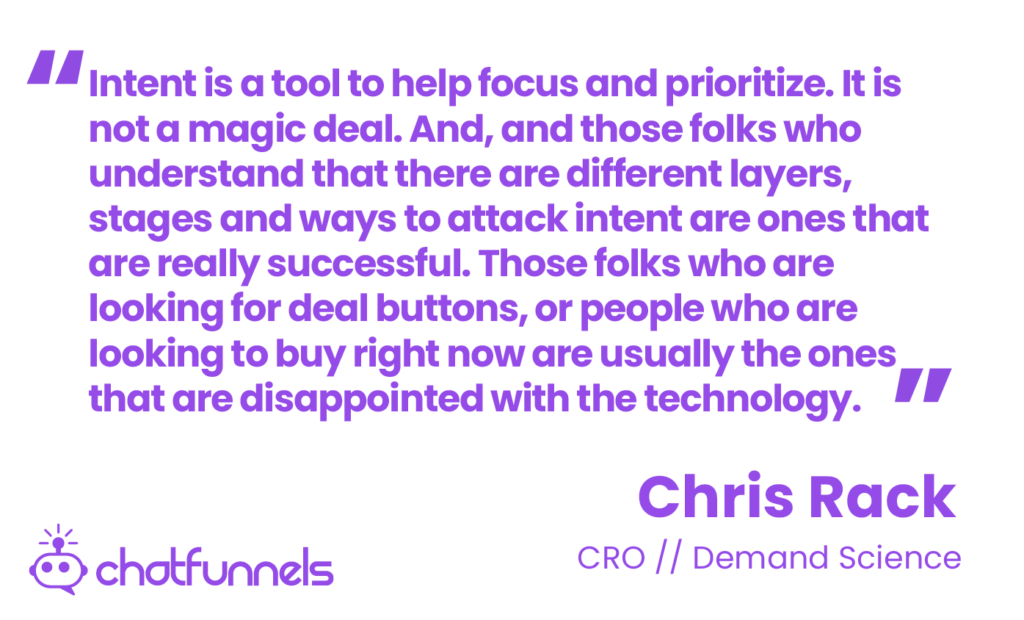
Billy Bateman 8:55
I like it, I like it. So, when you have those high intent accounts, and you realize like, okay, like, this looks like golden. What, how do you personalize for those high intent accounts? Is it just like the content that I’m reading? Or maybe, you know, the web pages that you’ve seen me visit? On your own website? Like, what do you guys’ view is like, hey, here’s the best way to personalize we found.
Chris Rack 9:26
You know, it really depends on the score on the stage. Not all, not all content is created equal. And there’s a different way to attack accounts at a different stage of intent. So, for us, we consider anything with a score of 50 or above actionable, and that’s showing intent across two of our four sources. When we have an account, that’s actionable marketing actually takes the reigns there.
I think the contacts in actionable accounts in your scores 50 to 60. And they’re sending out just thought leadership, just to start introducing our brand, or reintroducing our brand to those folks who are starting to begin their research in our product journey. Once the once that same account reaches a score of 75. And that’s either based on an additional source of intent or increased engagement with content in the first two sources, then sales, sales take over to 75.
And then we’re reaching out with very specific, very targeted email and phone scripts, trying to speak exactly to either the keywords that they have, or the value prop that we solve for that connects to one of those keywords.
Billy Bateman 10:27
Right. Okay.
Chris Rack 10:28
What kind of combination? Most folks look at intent. And I know some other vendors speak to the fact that intent is when folks are ready to buy, right? Yeah, really, really, you don’t, you don’t want to reach out to those people, when they’re ready to buy, you want to reach out to those people, when they first identify, they have a problem. You get there with marketing, when they’re when they first identified that problem. You’re not just another vendor on an RFP, you’re helping them frame the solution to that problem.
Billy Bateman 10:59
Yeah, then you’re then you’re really able to like, you know, I’m sure we’ve all read challenger sale. If you haven’t, you should, you’re able to really be that consultant and say, like, oh, these are the kinds of things you need to be looking for. And, and you can build it for your own product to a certain level. So, I love it. I love it.
So, you mentioned four different channels that you guys are looking at. For intent. I’m sure they’re all not created equal. I mean, my own opinion is there’s some of those that are more high intent than others. If you had to stack rank the different types of intent, how would you do that?
Using Several Sources for Intent
Chris Rack 11:31
I mean, websites, anybody who makes it to your personal website, I would stack rank them as the highest level of intent, right? Somebody who’s took something is taking the time to journey to you into what I call a community, right? That’s what your website is, you know, for a marketer, your website and your OPT in email database, that’s your community. So, anybody who you’ve invited to and decided to enter your community, that’s what I would consider those folks with the highest intent, prioritize my outreach there, then there are third party sources.
And third-party sources are folks that have either engaged with specific websites or specific content, right? I wouldn’t say that I wouldn’t to be candid stack rank anyone above the other. Because they all have their pot. Now they have all their pot, they all have positives and negatives. So and most people will stack rank them based on whatever their solution is.
So, you know, the real value is that and I’m probably giving you not the answer that you wanted. But each individual type of intent presents its own unique benefit, but also its unique drawback. Like, yeah, review, a review site, obviously, someone who reviews a review site might be pretty well in in their product research, too. But also, they might be done with their product research. And let’s not forget that, you know, review sites only get a really small amount of traffic monthly. Globally, you’re looking at maybe 50 60 million pageviews a month. In the grand scheme of the internet and the content that’s researched, it’s a very small amount.
So, you know, and again, looking at other weather, other types of intent that aggregate content consumption across hundreds of 1000s of sites, but that’s a good thing. You get your get your collecting intent over those sites, but you get a lot of false positives, of people who may not have actual intent, they may just be researching something.
So, the real, what I believe is that I believe that as a marketer, or as a salesperson, you should invest as much data as you can. In the world that we live in the world that we live in now, there is enough data out there that you should have a team compiling sources of data from multiple sources, whether it’s intent vendors, if I, you know, I use maybe sell intent, but I would buy other ones, just again, to collect more different types of intent, you know, from a sales perspective content, you know, contacts, direct dials, folks, you can reach out to. You know I use; I personally use three different contact databases.
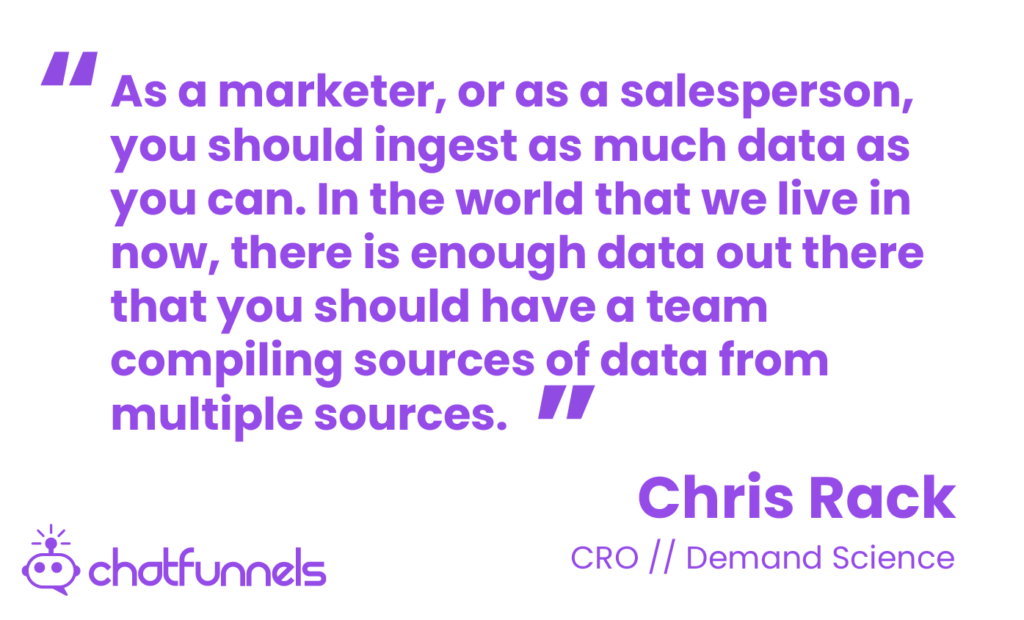
Yeah, just because you can only have so much data. And data is what really drives sales and marketing decisions across the law, the grand scheme of things. So, you know, stack ranking them, I can’t do it. But I would recommend that every sale or marketing buyer be buying at least two, if not three, or four different sources for intent, and other types of sales and marketing data, because you can, that that’s that money gives you significant ROI, just a cost of sale.
If that, if that 20k platform identifies, you know, five deals in a year, you know, that’s likely replacing 60, 70, 80k of headcount and manager cost that you have just by using data to be able to laser focus on the right people at the right time.
Billy Bateman 14:47
Yeah, like you won’t. You’re right, like, they’re all different. They’ll indicate different things. Like if you’re just relying on your website data, like you actually may be too late. Especially if you want to help form that RFP and what they’re looking for, you know, if they’ve already made it to your site, unless you are already the market leader, they probably looked at your competitors and even talked to a few of them.
So, okay, man, well, let me let me ask you this as well. So, if you’re getting all this intent data, I think something that a lot of companies struggle to actually get right is their ICP. Like, we all say, like, hey, this is our ICP, but does the data actually bear that out? Have you guys done anything where you can use that intent to realize you know what, maybe we thought, this is our ICP, but these are the people that actually gained intent. And this is probably who we should be targeting.
Reverse Engineering ICP Based on Intent
Chris Rack 15:45
Most ICPs. And I say this jokingly, but it’s actually quite true, I would be willing to bet most ICPs are created by five or six people sitting in a room declare, declaring who their ICP should be based on based on their experience or hunches in space, right? I mean, yeah, I’ve been in those rooms, right?
Billy Bateman 16:04
You’re not wrong.
Chris Rack 16:06
So, what we’re seeing in our space, and what we’ve done is actually you can reverse engineer ICP based on intent, right? Most people, when they go to when a tech platform like ours, login, type in their ICP first, you know, marketing, marketing managers, it costs software and tech companies have 100 plus in the US, and then they’ll layer attacks on their ICP.
So, but what you can do is you can actually backtrack and, and you could just pick a geography or even globally, and then just type in the intent, hold the full list out of the system with all the industry and company side information, and see what the data tells you. The date of May, the data may tell you that there’s 25% of your health care companies are showing intent for your product or service. If you don’t have a team focused on health care right now.
It might, it might show you that you’re you know, 75% of the company’s trending for intent in your topic right now are 1000 Plus large organizations, and you don’t have an enterprise strategic team. So, we did this and believe it or not, we did this in 2020. When, you know, we pulled this data, and it showed us that hey, you know, we were seeing the most intense signals and the most intent for our very specific keywords coming from, you know, large size company.
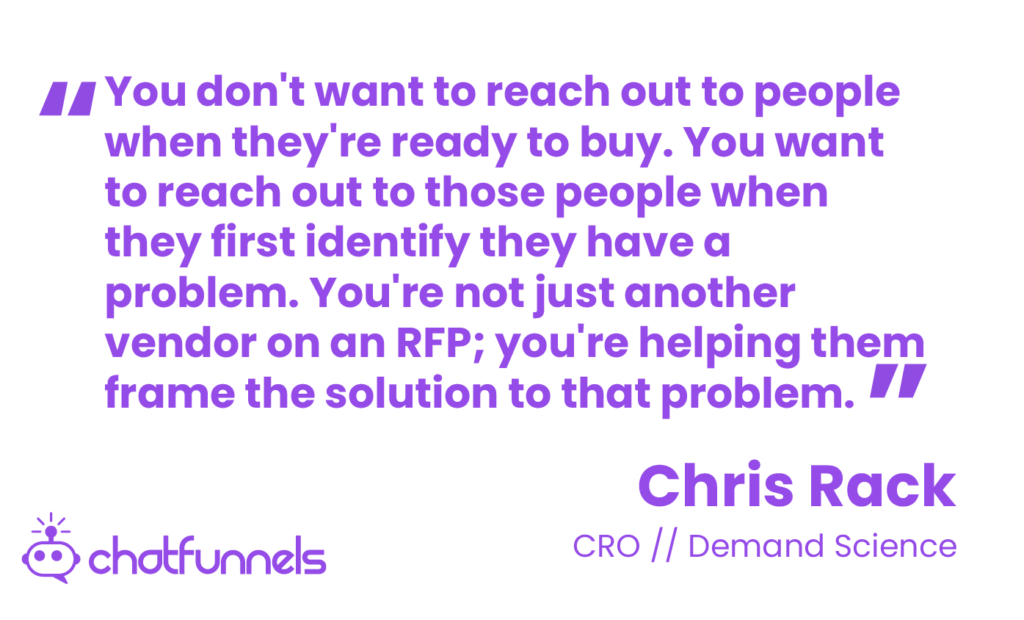
So, I built a team, specifically of strategic sellers focused on our top 50, what were identified as our top 50, you know, accounts based on the intent data that we saw, right. And that’s been one of the really key catalysts to our growth, is just pivoting and putting a very specific group of people on a very specific, very specific and small tab based on that data has really accelerated our revenue in the past year.
Billy Bateman 17:52
I love it, man. I love it. So, before I let you go, anything else that you can share with us around how you actually use intent data to get deals done? And to get them even just started? You know?
Chris Rack 18:07
Yeah, it’s, you know, it. First off it is not as complicated as you think. Right? Like, the biggest misconception is that you need 72 integrations and plugins. All I mean, I get that question all the time. Do you integrate with my 64, different tools and stacks and all that, right? Like, most, most things can be done by you know, CSVs, and uploads and downloads.
So, it’s not as overwhelming as you don’t, you also don’t necessarily need technology or a platform to do it. As I mentioned, intent, intent for you could really just be figuring out a way to identify the most the biggest trigger that drives the purchase of your product or solution, and then trying to consult that equation with a piece of technology, where you could solve that equation with a human, you know, an admin layer, identifying those folks, folks, for you.
So that’s, that would be my first, and second, you know, intent is intent is that is a tool, to help focus and prioritize. It is not, it is not a magic deal. But yeah. And, and those folks who understand that there are different layers, stages and ways to attack intent are ones that are really successful. Those folks who are looking for deal buttons, or people who are looking to buy right now are usually the ones that are disappointed with the technology. So, if anybody tells you that it’s a deal button, you should probably think twice about that relationship or purchasing from that person, because there isn’t anybody, I know who’s been able to identify that yet.
Billy Bateman 19:36
I love it, man. Thank you, man. So, Chris, if anyone wants to get ahold of you continue the conversation or learn more about Demand Science, what’s the best way for them to reach out?
Chris Rack 19:46
LinkedIn I’m always on LinkedIn. I’m pretty active. I post pretty regular videos on these types of topics. You could reach out to us at demand science calm as well. Right and somebody will get you connected to either myself directly or someone on my sales or, but You know I’m always reachable you know LinkedIn and email and email I’m chris.rack@demandscience.com.
Billy Bateman 20:10
Okay man thanks you so much and we’ll chat later.
Chris Rack 20:13
Billy, thank you so much, appreciate the time boss.
